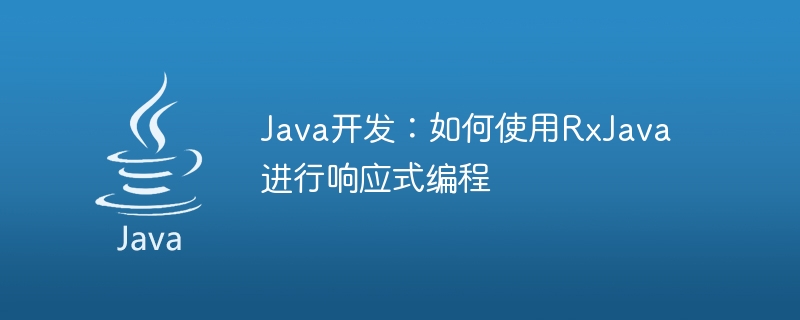Home >Java >javaTutorial >Java development: How to use RxJava for reactive programming
Java development: How to use RxJava for reactive programming
- 王林Original
- 2023-09-22 08:49:481174browse

Java development: How to use RxJava for reactive programming, specific code examples required
Introduction:
As the needs of modern software development continue to increase, traditional Programming methods can no longer meet the requirements for high concurrency, asynchronous processing, and event-driven features. In order to solve these problems, reactive programming came into being. As a powerful reactive programming library, RxJava provides rich operators and flexible asynchronous processing methods, which greatly improves development efficiency and application scalability. This article will introduce how to use RxJava for reactive programming and provide specific code examples.
1. Installation and configuration of RxJava
-
Add RxJava dependencies in the project’s pom.xml file:
<dependency> <groupId>io.reactivex.rxjava2</groupId> <artifactId>rxjava</artifactId> <version>2.2.21</version> </dependency>
-
Import RxJava related packages in the Java class:
import io.reactivex.Observable; import io.reactivex.Observer; import io.reactivex.disposables.Disposable;
2. Use RxJava to create Observable and Observer
In RxJava, Observable is used to emit data events, and Observer is used to process these data events. We can create Observable and Observer in the following ways:
-
Create Observable example:
Observable<String> observable = Observable.create(emitter -> { emitter.onNext("Hello"); emitter.onNext("World"); emitter.onComplete(); }); -
Create Observer example:
Observer<String> observer = new Observer<String>() { @Override public void onSubscribe(Disposable d) { // 当Observable和Observer建立订阅关系时会调用该方法 } @Override public void onNext(String s) { // 当Observable发射数据事件时会调用该方法 System.out.println(s); } @Override public void onError(Throwable e) { // 当Observable发生错误时会调用该方法 } @Override public void onComplete() { // 当Observable发射所有数据事件后会调用该方法 } };
3. Use RxJava operators for asynchronous processing and event conversion
RxJava provides a rich set of operators that can be used to process events emitted by Observable and convert data. The following are several commonly used operator examples:
-
map operator: used to convert events emitted by an Observable into another type of event.
Observable.just(1, 2, 3) .map(integer -> "Number: " + integer) .subscribe(System.out::println); // 输出: // Number: 1 // Number: 2 // Number: 3 -
filter operator: used to filter events emitted by Observable.
Observable.just(1, 2, 3, 4, 5) .filter(integer -> integer % 2 == 0) .subscribe(System.out::println); // 输出: // 2 // 4 -
flatMap operator: used to convert events emitted by an Observable into multiple Observables and merge them into one Observable emission.
Observable.just("Hello", "World") .flatMap(s -> Observable.fromArray(s.split(""))) .subscribe(System.out::println); // 输出: // H // e // l // l // o // W // o // r // l // d
4. Use Schedulers for thread switching
RxJava supports switching the event processing and subscription behavior of Observable to different threads to achieve asynchronous operations. The following are several commonly used Schedulers examples:
-
Schedulers.io(): used to handle I/O operations, such as reading and writing files, network requests, etc.
Observable.just("Hello", "World") .subscribeOn(Schedulers.io()) .observeOn(Schedulers.newThread()) .subscribe(System.out::println); -
Schedulers.computation(): used for computationally intensive operations, such as image processing, complex calculations, etc.
Observable.range(1, 10) .subscribeOn(Schedulers.computation()) .observeOn(Schedulers.newThread()) .subscribe(System.out::println); -
Schedulers.newThread(): used to create a new thread for operation.
Observable.just("Hello", "World") .subscribeOn(Schedulers.newThread()) .observeOn(Schedulers.io()) .subscribe(System.out::println);
5. Use Disposable for resource management
In RxJava, Disposable is used to manage subscription relationships and resource release. Here is a simple example:
Disposable disposable = Observable.just("Hello", "World")
.subscribe(System.out::println);
// 当不再需要观察这个Observable时,可以调用dispose()方法来释放资源
disposable.dispose(); Conclusion:
This article explains how to use RxJava for reactive programming and provides specific code examples. By using RxJava, we can easily handle asynchronous, event-driven and high-concurrency scenarios, improving development efficiency and application scalability. I hope this article can help readers better understand and apply RxJava related knowledge.
Reference materials:
- RxJava official website: https://github.com/ReactiveX/RxJava
- RxJava Chinese documentation: https://mcxiaoke.gitbooks. io/rxdocs/content/
- Detailed explanation of RxJava operators: https://www.jianshu.com/p/6e17c7f4e8c0
The above is the detailed content of Java development: How to use RxJava for reactive programming. For more information, please follow other related articles on the PHP Chinese website!

